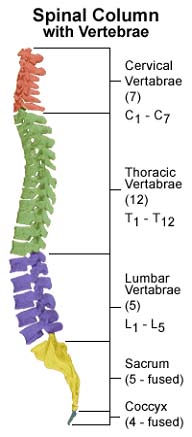A healthy spine has two natural curves which help to balance the body as it moves and give it the ability to adapt to the shifting of weight. Kyphosis is a condition in which an unnatural, excessive curvature of the spine develops, causing an individual to appear to be slouching or to have a hunchback. Two words anatomists use to describe spine curves are lordic and kyphositic. A lordic, or lordotic curve, has the opening of the C facing behind the person. A kyphosis curve has the opening of the C facing forward. The normal spine has both in limited amounts – kyphosis at the top and lordic at the bottom. But when the whole spine is one C facing either direction something is wrong. A kyphositic curve that is too large is a medical condition. The bigger the curve, the bigger the problem.
Kyphosis usually affects the thoracic area  of the spine, but it can manifest in the lumbar and cervical areas. People with advanced osteoporosis sometimes develop kyphosis. Other causes of the condition include osteomalacia and osteonecrosis. Degenerative disk disease from other causes also produces kyphosis. Trauma and laminectomy surgery can also result in kyphosis.
of the spine, but it can manifest in the lumbar and cervical areas. People with advanced osteoporosis sometimes develop kyphosis. Other causes of the condition include osteomalacia and osteonecrosis. Degenerative disk disease from other causes also produces kyphosis. Trauma and laminectomy surgery can also result in kyphosis.
Dowager's hump is a somewhat archaic term applied to the forward bend in the upper spine in older people. More technically called age-associated hyperkyphosis, it can be the result of untreated osteoporosis.
Kyphosis can be diagnosed several ways. A doctor may first suspect the condition based on a physical examination or a patient’s symptoms such as axial back pain, tingling, weakness, or paralysis. By feeling along the spine, the physician can determine if there is a curvature outside the normal range. To confirm a diagnosis of kyphosis, doctors may order some or all of the following:
While some patients with milder forms of kyphosis may experience only cosmetic symptoms, such as a rounding of the back and shoulders, others experience back pain, fatigue, and soreness in the spinal area. Although most people think of kyphosis in connection with the elderly, this disorder can affect all ages, including children. The most severe cases of kyphosis can even interfere with the ability to move air in and out of the lungs. Doctors will usually consider surgical intervention or fusion of the spine when the kyphosis is thirty degrees or more or if a patient has lost more than half of his or her anterior vertebral height.
Treatment for kyphosis depends on the type and severity of the disorder. Because the types of kyphosis are so different, the treatment options also vary. Children born with congenital kyphosis could need corrective surgery during childhood to prevent damage to other parts of the body. Sometimes childhood kyphosis, caused by a condition such as Scheuermann’s disease, responds well to physical therapy and a brace. Scoliosis can result in the development of kyphosis in teenagers, and early treatment of this condition usually involves a brace. Without early intervention, the kyphosis caused by scoliosis may require surgery and a body cast.
Older adults who develop kyphosis due to osteoporosis may only need treatment for their bone loss. When a tumor or infection causes kyphosis to develop, doctors will usually choose more aggressive treatments, such as medication or surgery. Surgery is done for if the kyphosis becomes painful or incapacitating. Elderly patients with kyphosis can have trouble maintaining balance while walking or sitting. In addition, kyphosis can lead to bed sores because of the pressure on the skin caused by deformity of the bone.
When kyphosis goes untreated, it can lead to medical complications that are more dangerous and difficult to treat. Early intervention can reduce the likelihood of the following complications:
Spanish page on kyphosis.

Bisphosphonates block bone resorption. They have been widely used for years and although there can be side effects, the medical profession considers them generally safe and effective. More
Selective Estrogen Receptor Modulators (SERMs) are chemical compounds that act on the estrogen receptors in the body. More.
